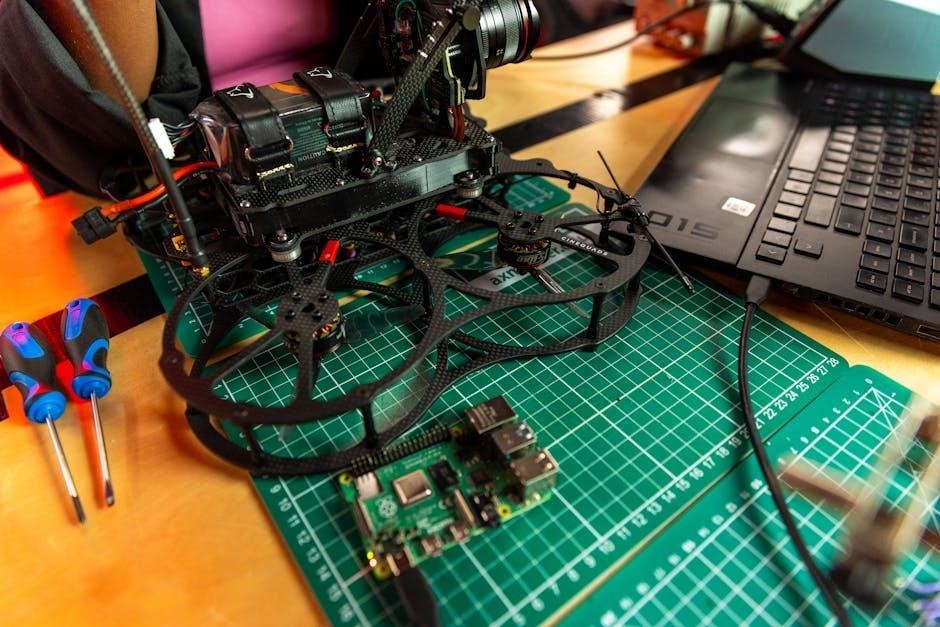The Honeywell TH5220D1003 is a digital thermostat designed for precise temperature control and energy efficiency. It offers advanced programming features‚ easy installation‚ and user-friendly navigation‚ making it ideal for home comfort. With its sleek design and robust functionality‚ this thermostat ensures optimal heating and cooling performance while minimizing energy consumption. The TH5220D1003 is compatible with various HVAC systems and provides customizable settings to meet individual preferences. Its intuitive interface and detailed manual guide users through setup and operation‚ ensuring seamless integration into any home environment. This thermostat is a reliable choice for modern households seeking convenience and efficiency.
1.1 Overview of the Honeywell TH5220D1003 Model
The Honeywell TH5220D1003 is a digital thermostat designed for efficient temperature control and seamless integration with various HVAC systems. It features a user-friendly interface‚ programmable settings‚ and advanced energy-saving modes. This model is known for its compatibility with gas unit heaters‚ duct furnaces‚ and other heating systems‚ making it versatile for different home setups. The thermostat’s sleek design and intuitive navigation ensure easy operation‚ while its detailed manual provides step-by-step guidance for installation‚ configuration‚ and troubleshooting. With its focus on precision and energy efficiency‚ the TH5220D1003 is an ideal choice for homeowners seeking a reliable and modern temperature control solution.
1.2 Importance of the Programming Manual
The programming manual for the Honeywell TH5220D1003 thermostat is essential for ensuring proper installation‚ configuration‚ and operation. It provides detailed instructions for wiring‚ system setup‚ and troubleshooting‚ which are critical for safe and efficient use. The manual guides users through initial power-on procedures‚ time and date settings‚ and basic temperature configurations. It also covers advanced features like scheduling and energy-saving modes‚ helping users maximize comfort and energy efficiency. By following the manual‚ users can avoid common errors and ensure optimal performance. Regularly referencing the manual is recommended for maintenance‚ updates‚ and addressing any operational issues that may arise.

Pre-Installation Requirements
Pre-installation requirements ensure the Honeywell TH5220D1003 thermostat is compatible with your HVAC system. Check system type‚ voltage‚ and wiring. Gather necessary tools and materials. Ensure the system is ready for thermostat installation. Follow safety guidelines and refer to the manual for specific instructions.

2.1 Compatibility Check for HVAC Systems
Ensure the Honeywell TH5220D1003 thermostat is compatible with your HVAC system. Verify system type (heating‚ cooling‚ or heat pump) and voltage requirements (24V AC). Check wiring configuration to match terminal connections. Consult the manual for specific compatibility details. Confirm the thermostat supports your system’s stages (e.g.‚ single-stage‚ multi-stage). If unsure‚ contact a professional or the manufacturer for clarification. Proper compatibility ensures safe and efficient operation. Incompatible systems may lead to malfunction or damage. Always follow the manual’s guidelines for a seamless installation process.
2.2 Tools and Materials Needed
To install the Honeywell TH5220D1003 thermostat‚ gather the necessary tools and materials. You will need a screwdriver (Phillips and flathead)‚ wire strippers‚ and a voltage tester for safe electrical work. Ensure you have the thermostat unit‚ its mounting hardware (screws and wall anchors)‚ and the user manual. Additionally‚ prepare a pencil for marking wire connections and a ladder or step stool for accessing the old thermostat. Safety gear like gloves and goggles is recommended. Verify all items are included in the packaging or available beforehand to avoid delays. Refer to the manual for specific recommendations tailored to your HVAC system.

Installation Process
Install the Honeywell TH5220D1003 thermostat by first turning off power to the HVAC system. Remove the old thermostat‚ then prepare and mount the new device. Connect wires carefully‚ following the manual’s wiring diagram. Secure the thermostat to the wall and restore power. Test functionality to ensure proper operation. Refer to the manual for detailed steps and safety precautions during installation.
3.1 Preparing the Thermostat for Installation
Before installing the Honeywell TH5220D1003‚ ensure the thermostat is properly prepared. Carefully unpack the device and verify all components are included. Check compatibility with your HVAC system using the manual. Turn off power to the system at the circuit breaker. Label existing wires for easy identification. Remove the old thermostat and clean the area. Ensure the new thermostat is set to the correct voltage (24V) if applicable. Consult the manual for specific preparation steps tailored to your system type. This ensures a smooth and safe installation process‚ avoiding potential damage or electrical issues.
3.2 Wiring Connections and Terminal Setup
Proper wiring is critical for the Honeywell TH5220D1003 thermostat to function correctly. Start by turning off power to the HVAC system at the circuit breaker. Locate the terminal labels on the old thermostat and match them to the new device. Use the wiring diagram in the manual to ensure correct connections. Secure the wires to the appropriate terminals using a screwdriver. Double-check for loose connections‚ as they can cause malfunctions. If your system uses a common wire (C)‚ ensure it is connected to the C terminal. Verify compatibility with your HVAC system type (e.g.‚ heat pump‚ gas furnace). Once wired‚ restore power and test the system to ensure proper operation;
3.3 Mounting the Thermostat on the Wall
Mounting the Honeywell TH5220D1003 thermostat requires careful preparation to ensure proper installation. Begin by removing the old thermostat and marking the wall for the new mounting location. Use a level to ensure the base plate is straight. Drill pilot holes if necessary and secure the base plate using the provided screws or wall anchors. Gently snap the thermostat onto the base plate‚ ensuring it clicks into place. Avoid touching the screen to prevent damage. If the wall surface is uneven‚ use the included spacers to level the device. Once mounted‚ double-check the alignment and ensure all components are securely fastened before proceeding to wiring or programming.

Basic Programming Setup
Basic programming setup for the Honeywell TH5220D1003 involves initializing the thermostat’s core functions. This includes setting the time‚ date‚ and basic temperature parameters to establish a daily routine and ensure optimal comfort.
4.1 Initial Power-On and System Recognition
Upon initial power-on‚ the Honeywell TH5220D1003 thermostat performs a system recognition process to identify the type of HVAC equipment connected. This step ensures compatibility and proper functionality. The thermostat will display a series of messages or LEDs to indicate the progress of the system check. During this phase‚ it detects whether the system is heating‚ cooling‚ or both‚ and configures default settings accordingly. Once the system is recognized‚ the thermostat will prompt you to confirm the detected settings or allow you to manually adjust them if necessary. This initial setup is crucial for accurate temperature control and efficient operation.
4.2 Setting Time and Date
Setting the time and date on the Honeywell TH5220D1003 thermostat is essential for accurate scheduling and operation. To begin‚ press the “Menu” button to access the configuration settings. Navigate to the “Clock” or “Time and Date” option using the arrow keys. Use the up and down arrows to adjust the hour‚ minute‚ and AM/PM settings. Next‚ confirm the time zone to ensure the thermostat operates correctly with local time. Finally‚ set the date using the same navigation method. Once all adjustments are made‚ press “Done” to save the changes. An accurate clock ensures proper temperature scheduling and energy management. The backlit display makes it easy to verify the time and date at any moment.

4.3 Configuring Basic Temperature Settings
Configuring basic temperature settings on the Honeywell TH5220D1003 ensures optimal heating and cooling performance. Start by setting the desired heating and cooling temperatures. Use the up and down arrows to adjust the setpoints. The thermostat allows you to set a temperature range‚ ensuring the system operates within comfortable limits. Additionally‚ you can configure the temperature differential‚ which determines how much the temperature can vary before the system activates. It’s important to set realistic values to balance comfort and energy efficiency. Finally‚ enable the “Temperature Hold” feature if you want to maintain a constant temperature for an extended period. Properly configured settings ensure consistent indoor comfort and energy savings.

Advanced Programming Features
Advanced features include scheduling‚ energy-saving modes‚ and temperature adjustments. These settings optimize comfort and efficiency‚ allowing customization to suit specific needs and preferences effectively.
5.1 Scheduling Temperature Setpoints
The Honeywell TH5220D1003 allows users to create customized temperature schedules for optimal comfort and energy efficiency. By programming setpoints‚ you can adjust temperatures based on the time of day‚ ensuring your home is heated or cooled only when needed. The thermostat supports multiple periods per day‚ enabling flexibility for different lifestyles. For example‚ you can set a lower temperature during sleep hours or when the house is unoccupied. This feature not only enhances convenience but also helps reduce energy consumption. Users can easily configure these schedules through the thermostat’s interface‚ ensuring consistent comfort while minimizing energy waste. Regularly reviewing and adjusting these setpoints can further optimize performance.
5.2 Enabling Energy-Saving Modes
Enabling energy-saving modes on the Honeywell TH5220D1003 helps reduce energy consumption while maintaining comfort. The thermostat features built-in energy-saving options‚ such as automatic energy-saving periods and smart recovery‚ which adjust temperatures based on your schedule. These modes ensure the HVAC system operates efficiently‚ lowering utility bills. Users can activate these settings during installation or through the programming menu. The thermostat also provides feedback on energy usage‚ allowing for further optimizations. By enabling these modes‚ homeowners can achieve a balance between energy savings and personalized comfort‚ making it an eco-friendly and cost-effective solution for heating and cooling needs.
5.3 Adjusting Temperature Hold and Override Options
The Honeywell TH5220D1003 allows users to adjust temperature hold and override options for enhanced control. The temperature hold feature lets you lock the current temperature‚ preventing accidental changes. To activate it‚ navigate to the settings menu and select “Temperature Hold.” For temporary adjustments‚ the override option enables you to modify the setpoint without altering the schedule. This is useful for unexpected changes in occupancy or comfort needs. Both features can be customized to suit your preferences‚ ensuring energy efficiency and consistent comfort. Proper use of these options optimizes system performance and aligns with your lifestyle.

Troubleshooting Common Issues
Troubleshooting the Honeywell TH5220D1003 involves checking error codes‚ verifying wiring connections‚ and ensuring proper system compatibility. Refer to the manual for specific solutions and resets.
6.1 Identifying Error Codes and Alarms
The Honeywell TH5220D1003 displays error codes to indicate specific issues‚ such as system malfunctions or sensor problems. Common error codes include E1‚ E2‚ and E3‚ which relate to temperature differences‚ sensor faults‚ or communication errors. When an error occurs‚ the thermostat will flash the code on its display or emit beeps. Refer to the programming manual for a detailed list of error codes and their meanings. Identifying the correct error code is crucial for troubleshooting effectively. Always ensure the system is powered on and sensors are clean before diagnosing. If errors persist‚ consult the manual or contact a professional for assistance.
6.2 Resolving Communication Errors
Communication errors on the Honeywell TH5220D1003 often occur due to wiring issues or system connectivity problems. First‚ ensure all wires are securely connected to the correct terminals. Verify that the thermostat is properly paired with the HVAC system. Power cycle the thermostat by turning it off at the circuit breaker‚ waiting 30 seconds‚ and then restoring power. If the issue persists‚ check for loose connections or damaged wires. Resetting the thermostat to factory settings may also resolve communication errors. If problems continue‚ update the thermostat’s firmware or consult the programming manual for advanced troubleshooting steps. Contact a professional if the issue remains unresolved.
6.3 Addressing Heating or Cooling System Malfunctions
If the heating or cooling system fails to respond to the thermostat‚ start by verifying the temperature settings and schedule. Ensure the system is set to the correct mode (heat/cool) and that the desired temperature is set. Check for any wiring issues or loose connections‚ as this can prevent the system from functioning. Verify that the HVAC system’s power switch is on and that the circuit breaker hasn’t tripped. If the issue persists‚ reset the thermostat by removing the batteries or turning off the power at the breaker. If the problem remains unresolved‚ consult the programming manual or contact a licensed HVAC technician for professional assistance.

Maintenance and Upkeep
Regular maintenance ensures optimal performance and longevity of the Honeywell TH5220D1003 thermostat. Replace batteries annually‚ clean the display‚ and check system calibration for accuracy. Schedule periodic checks of wiring connections and ensure proper airflow around the device. Replace air filters and inspect HVAC components to maintain efficiency. Update firmware when available to access new features and improvements. Perform these tasks to ensure reliable operation and precise temperature control year-round.
7.1 Cleaning the Thermostat Display and Sensors
Cleaning the Honeywell TH5220D1003 thermostat is essential for maintaining accuracy and functionality. Use a soft‚ dry cloth to gently wipe the display screen‚ removing dust or fingerprints. For the sensors‚ turn off power to the thermostat and carefully clean with a cotton swab. Avoid harsh chemicals or moisture‚ as they can damage components. Regular cleaning prevents dust buildup‚ ensuring precise temperature readings. Also‚ inspect and clean the thermostat’s exterior to maintain proper airflow. Cleaning should be done every 3-6 months or when visible dust accumulates. This simple maintenance step helps ensure reliable performance and accurate temperature control.
7.2 Updating Firmware or Software
Updating the firmware or software of the Honeywell TH5220D1003 thermostat is crucial for ensuring optimal performance and accessing new features. Begin by checking the current firmware version on the thermostat. Visit Honeywell’s official website to download the latest version‚ typically available as a .zip file. Insert a USB drive into your computer‚ transfer the update file‚ and then plug the USB into the thermostat. Follow the on-screen instructions to complete the update process. Ensure the thermostat remains powered on during the update to avoid interruptions. After installation‚ restart the device to apply changes. Always refer to the manual for specific steps‚ as updates may vary. Regular updates enhance functionality and reliability.

Additional Features and Customization
The Honeywell TH5220D1003 offers advanced customization options‚ including custom temperature limits‚ energy usage reports‚ and smart home integration. These features enhance comfort and efficiency while providing personalized control.
8.1 Integrating with Smart Home Systems
The Honeywell TH5220D1003 thermostat can seamlessly integrate with popular smart home systems‚ such as Samsung SmartThings‚ to enhance control and automation. Users can access advanced features like voice control through Amazon Alexa or Google Assistant‚ enabling hands-free temperature adjustments. This integration allows for synchronized operation with other smart devices‚ creating a unified home automation experience.
Through the Honeywell Home app‚ users can remotely monitor and adjust settings‚ receive notifications‚ and optimize energy usage. Smart home integration also enables geofencing‚ adjusting temperatures based on location‚ and scheduling Scenes for effortless management of your home’s comfort and energy efficiency.
8.2 Customizing Temperature Limits and Alerts
The Honeywell TH5220D1003 allows users to customize temperature limits and alerts to maintain optimal comfort and energy efficiency. By setting maximum and minimum temperature thresholds‚ homeowners can prevent extreme temperatures that may damage equipment or increase energy bills. Customizable alerts notify users when temperatures exceed these limits‚ ensuring prompt action. Additionally‚ users can program alerts for system performance issues‚ such as when the temperature isn’t changing as expected. These features provide peace of mind and help maintain consistent indoor conditions. Adjusting these settings is straightforward through the thermostat’s menu or the Honeywell Home app‚ offering flexibility and convenience.
This customization ensures the system operates within desired parameters‚ balancing comfort and energy savings.
The Honeywell TH5220D1003 programming manual guides users to optimize their thermostat’s performance‚ ensuring energy efficiency and comfort through customizable settings and advanced features.
By following the manual‚ users can maximize their system’s potential and enjoy a seamless smart home experience with tailored temperature control and energy-saving capabilities.
9.1 Summary of Key Programming Steps
Programming the Honeywell TH5220D1003 involves initializing the system‚ setting the time and date‚ and configuring basic temperature settings. Users should schedule temperature setpoints for energy efficiency‚ enable energy-saving modes‚ and adjust temperature hold/override options. Advanced features like integrating with smart home systems and customizing alerts can enhance functionality. Regular maintenance‚ such as cleaning the display and updating firmware‚ ensures optimal performance. Troubleshooting common issues‚ like error codes or communication errors‚ helps maintain system reliability. By following these steps‚ users can fully utilize the thermostat’s capabilities‚ ensuring comfort and energy savings while minimizing operational disruptions.
9.2 Final Tips for Optimal Performance
To ensure the Honeywell TH5220D1003 operates at its best‚ regularly clean the display and sensors to maintain accuracy. Check and replace batteries as needed to prevent interruptions. Optimize temperature settings for energy efficiency while balancing comfort; Avoid placing the thermostat near direct sunlight or drafts‚ as this can affect temperature readings. Periodically review and adjust schedules to align with lifestyle changes. Keep the thermostat firmware updated for the latest features and improvements. By following these tips‚ users can maximize energy savings‚ extend the device’s lifespan‚ and enjoy consistent heating and cooling performance throughout the year.
